During the past three years, Chinese access control suppliers have obtained experience by working on small to mid-sized projects. Chinese-made keypad locks and card readers are selling well overseas because of competitive prices.
During the past three years, Chinese access control suppliers have obtained experience by working on small to mid-sized projects. Chinese-made keypad locks and card readers are selling well overseas because of competitive prices.

Access control has developed slowly in China. According to Jing Wang, Vice Manager of Kingdom Elid, "In China, the concept of access control was introduced later than in other countriesin around 1997. Before that, the main access control products were from international companies. Many installers and end-users did not know what access control was or what it could be used for."
There are three types of access control suppliers in China: simple hardware (readers, sensors and entry-level controllers) suppliers, building solution (readers, turnstiles, gates and systems) access control providers and medium enterprise solution (higher scale system combination) providers. The most mature techniques are one-card solutions and access control solutions with biometric technology since one of the advantages of these types of technology is that they are easy to upgrade.
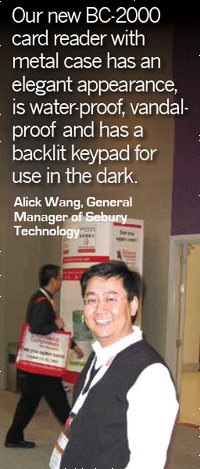
If end-users already have RFID or biometric technology, they can add access control and vice versa. "Biometrics is very powerful because it brings access control down to the personal level," said Alick Wang, General Manager of Sebury Technology. "Identification is important when it comes to access control. Some traditional technologies do not necessarily provide the best security. When using a swipe card or password, all you are really saying is that the card or password belongs in the building. With biometrics, you can say this person belongs in the building," said Alick.
According to Wang, the company's new BC-2000 card reader has a metal case as well as an elegant appearance; the product is water-proof, vandalproof and has a backlit keypad for use in the dark. "This has made it very popular with European customers." Potential verticals are pharmaceutical companies, government agencies and any other company with strict compliance issues.
Programmable Components
Programmable electronic locks allow enterprises or owners to connect doors for comprehensive systems. The same credentials are used throughout a facility or even multiple facilities. Electronic systems allow even intermixing of credentials, using systems as simple as electronic PIN-enabled locks or those as
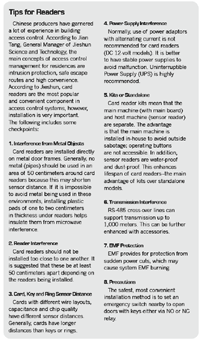
sophisticated as online wireless configurations that connect doors or even elevators to existing access control systems. Programmable electronic locks are one choice for facilities with a limited number of users and access points.
"Keypad units feature at least 12-key membranes and different LED displays," said Wang. "Keypads are compatible with all access controllers; they are often used in conjunction with various types of readers, while electronic locking systems are also at a price point of mechanical single-code locks. With such devices, staff can quickly program up to 120 individual user codes, right at the keypad." Administrators can add or delete users in about 10 seconds. Electronic programmable locking systems operate on four AA alkaline batteries, which last about three years. Computer-managed locking systems are networked through software to provide audit trail capability and time-based scheduling for restricting access.
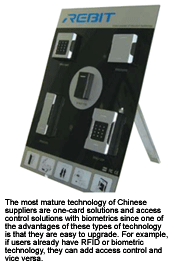
Security can be enhanced by increasing the frequency with which codes are changed; this reduces labor and cost of access management as well as liability; the moment an employee who knows an access code quits the company, office security is then at risk. As soon as an employee leaves the company or a newcomer joins the firm, administrators can immediately delete an old code or add a new one at the keypad to maintain increased security. This prevents the building from having to continually rekey a lock whenever an employee quits or mechanical keys are missing.
Controllers: from Wire to Wireless
The main process for access control is as follows: from card to card reader to controller to PC to network. The first priority for any access control plan is to establish control over the origination and duplication of mechanical keys. Whether it is an important closet, research lab, computer room, office or bank, a programmable locking system eliminates distribution of keys. If there is a need to provide controlled access to multiple users sharing access to multiple openings, programmable electronic locks and trims are the first step in a migration from mechanical key systems to fully electronic access control.
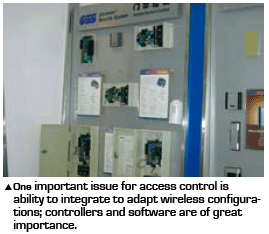
The ideas are simple; the solutions are various. Another important issue for access control is ability to integrate to adapt wireless configurations; controllers and software are of great importance. Take the controllers from Integrated Corp. for example; these support single to numerous door installations, and provide enlarged system storage capacity with RS422 and Wiegand communication format for a wide range of readers.
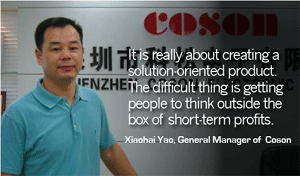
Meanwhile, the Kingdom Elid controller (SK1000) also maximizes methods of configuring an integrated security system. On its own, it can become a LAN node. This is made possible by assigning an IP address and connecting it to a nearby UTP hub. Users may even use SK1000 controllers for a WAN configuration. "I agree that the trend for access control is wireless since these systems use less hardware and can be installed up to 10 times faster than those that require cable," said Xiaohai Yao, General Manager of Coson Electronics. Wireless systems come at an even lower installed cost than an online access control system. Usually, a wireless system can integrate into existing access control systems while allowing employees to continue to use existing keys or ID credentials. "When planning the upgrade from mechanical to electronic, networked or wireless locking systems," explained Wang, "the transition should be taken bit by bit starting from the core divisions of each building. Adding electronic locking systems to access points can be a sensible migration plan for enterprises because of budget and time factors. The initial cost may be more, but remember that you spend more money rekeying a facility if any key is missing. Plus, you can change the code and your facility is secure again in a matter of minutes. Electronic locks are easy to program and use and require almost no maintenance."
Systems and Software
Systems contain higher technical entry barriers, so Chinese suppliers are still working to catch up. Large construction projects have raised the standard of solutions and technology at Coson, Kingdom Elid, Integrated Corp., Jieshun, D-One (Neatech), Newabel and Peak. "Honestly, access control suppliers are offering more or less the same solutions. The major difference is field of customers," commented Yengda Tong, Sales Manager of Newabel. "Newabel specializes in telecommunications. In China, there are five big telecommunication companies; four of them are cooperating with Newabel."
Jieshun Science and Technology, which was established in 1992, is well-known for residential and airport projects. "Successful projects that we have worked on include buildings, parking lots and airports. We also have a major share of government construction projects," said Jian Tang, General Manager of Jieshun.

Meanwhile, Coson is more focused on mid-sized government, intelligent building, university, military base and bank projects. "Residential is providing the biggest demand for access control; the sector requires a lot of after-sales service." The main challenge is for higher scale solutions such as control systems for 200,000 passengers and 100 aisles. "We provide an open protocol for customers to modify their customized software when they have plans to introduce our products. We are looking for professional system integrators who have been doing access control for many years. We target long-term business; we are also strengthening international sales." For small or mid-sized projects, current software can manage most credentials, while controlling locks, access trim and offline hard-wired controllers, which manage strikes and magnets from any PC, such as the Integrated Corp.'s Electronic Map subsystem 2.0 or D.One's SecurityGate 1.4. New users, access points and access privileges can be entered into the system in seconds.
They also provide an audit trail. An administrator goes to the opening, plugs in the interface to the locking system right at the door and uploads new access instructions to the lock while downloading audits of who has been through the door and when. This function can also be used to assign access rights by credential and/or time.
Kingdom Elid SsofNET systems provide selectable functions, including time zones, time activation and expiration, auto unlock time scheduling, first person-in and holiday scheduling. A variety of reports are available to help manage a facility more efficiently, including audit trail data, access privileges data and time function schedules by user or door.
Quality and Service
The most critical factor in access control is service. Pre-sales service includes detailed user manual and hardware indications and planning; sales service encompasses wire planning and installation; after-sales service means on-site checks after construction, maintenance, software updates, trouble shooting and training. "Installers may be out of business, but end-users still require servicing. Coson has customer service engineers on standby and we also keep regular contact with customers. Initially, we provide the service for free; later, we may use service contracts if the customers do not have a specific installer to support them." "Sometimes, domestic users complain to me about purchasing cheap products that are dead-onarrival," observed Wang. "Then, they go back to the suppliers without luck because either the producers hide or they close the business. Honestly, I am sure that these cheap Chinese access control makers will be forced out of the game in a couple of years; only the good suppliers will remain. At this time, we are still working hard to catch up with excellent international solution providers."
To guarantee quality, producers age test products from two days to seven days. "It is also important to have a well-designed anti-strike protection for access controllers. It is very dangerous when strikes threaten the whole building and stability of the complete system might be affected,〃 said Yao. "Quality," said Tong, "has to be ensured in the following three ways: production lines, procedures and certification. At Newabel, we design our own models rather than purchasing pret-a-porter cases from HID or Motorola. We also have achieved ISO9001 certification."
Exports and Vision
"Our Malaysian colleagues," said Wang. "believe that Chinese keypad locks and card readers are selling well in overseas market because of competitive prices. Actually, international buyers may not even remember the brand names because these products feature only simple techniques. Access control systems and solutions with more advanced technology require customization; that makes them harder to export." "Newabel has good screen display technology," said Tong. "We specialize in sensors such as our CHD301C series with temperature sensors. This year, we are developing new products and recruiting professional overseas sales teams. We have system integrator customers in Canada and Hong Kong, but we think that it is possible to go for distributors since we have a full series of solutions from simple to complex."
"Access control profits," said Yao, "are better, but there is more and more low-priced hardware such as card readers or simple controller on the market. Suppliers without special products kill themselves in price wars. Success means creating a solutionoriented product. There is always a learning curve with new technology. The difficult thing is getting people to think outside the box of short-term profits."